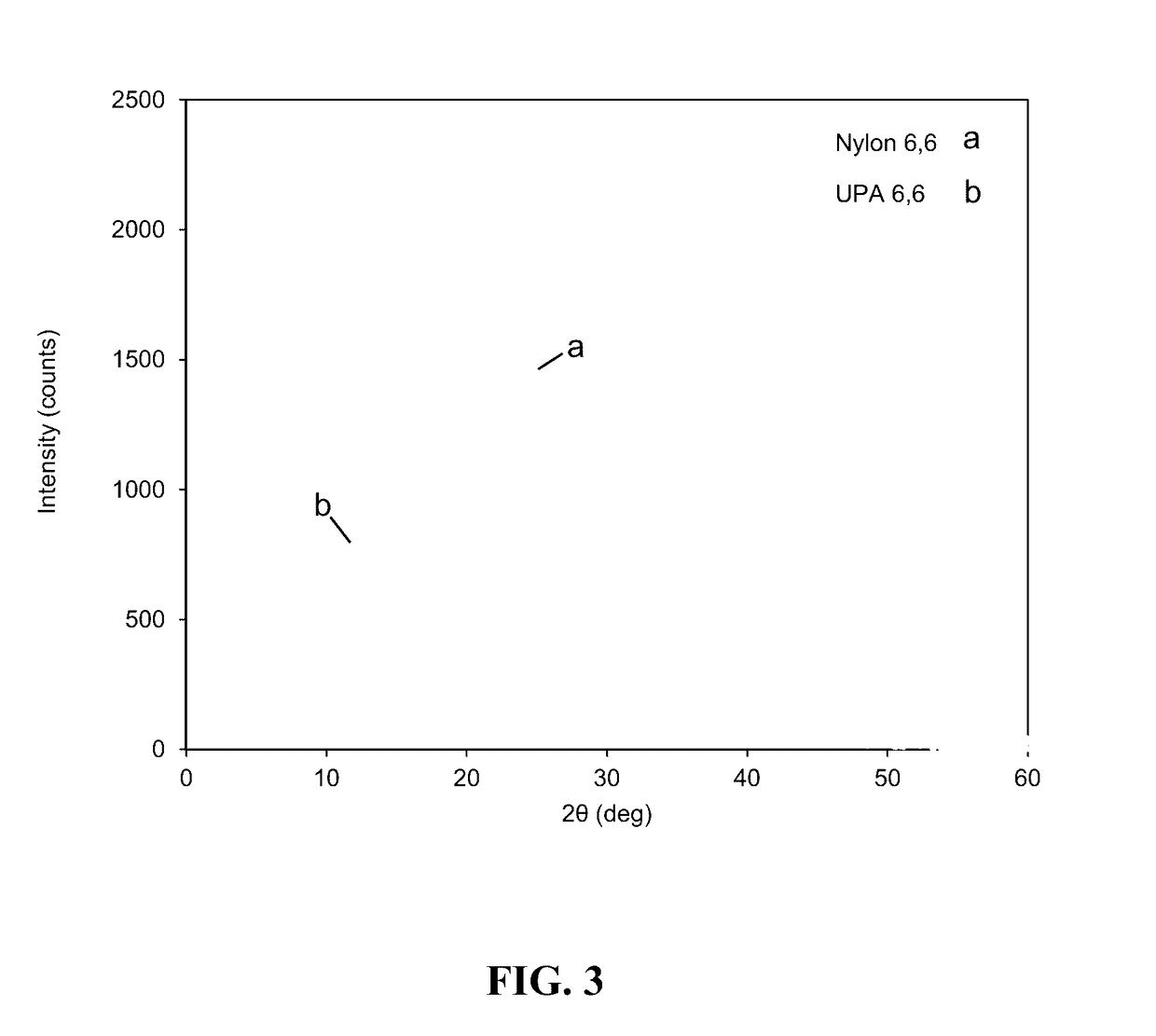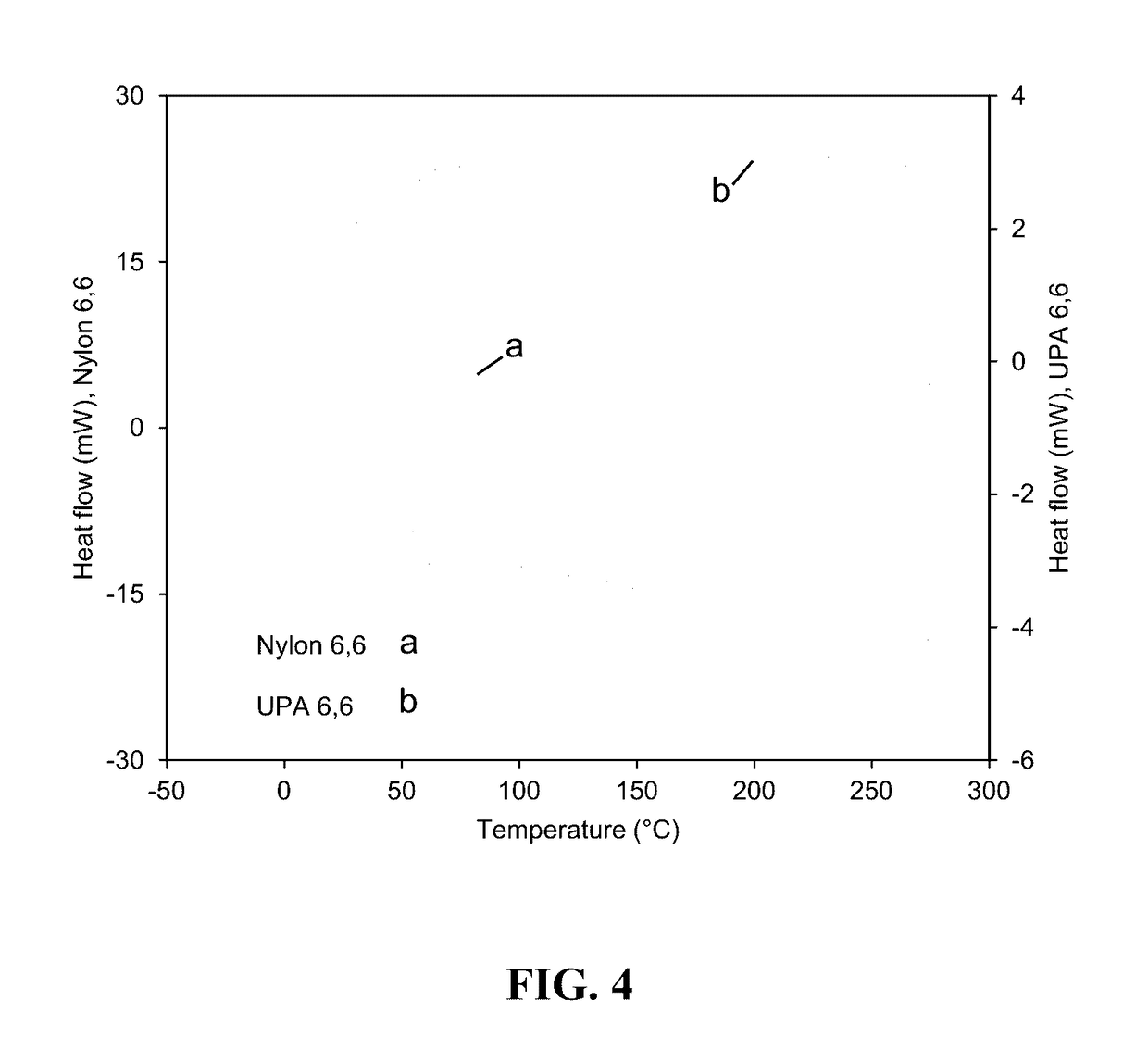Bioadvantaged nylon: polycondensation of 3-hexenedioic acid with hexamethylenediamine
a technology of hexamethylenediamine and bioadvantaged nylon, which is applied in the field of bioadvantaged nylon, can solve the problems of poor adhesion of nylon to other polymers, poor surface wettability and hygroscopicity, and achieve the effect of reducing hygroscopicity
- Summary
- Abstract
- Description
- Claims
- Application Information
AI Technical Summary
Benefits of technology
Problems solved by technology
Method used
Image
Examples
example 1
of Nylon 6,6
[0244]The polycondensation reaction between trans-3-hexenedioic acid and hexamethylenediamine was adapted from the synthesis of nylon 6,6 [U.S. Pat. No. 4,251,653 to Eckell et al. and U.S. Pat. No. 4,442,260 to Larsen, which are hereby incorporated by reference in their entirety]. Detailed, trans-3-hexenedioic acid was purchased from TCI America, dissolved in methanol, and mixed with a 1:1 mole ratio of hexamethylenediamine dissolved in methanol. The resulting solution was heated in a round bottom flask at 60° C. The liquid was decanted from the precipitated salt. The precipitated salt was subsequently washed with methanol, decanted, and left to dry in a fume hood. To further polymerize the salt formed, 6.08 g was massed and mixed with 7.07 mL of deionized water. The resulting solution was put in an aluminum weigh pan and heated at 7.5° C. / min to 250° C. in a tube furnace under flowing ultra-high purity nitrogen. The sample dwelled at the temperature for 30 min before co...
example 2
usion Chromatography (SEC)
[0245]Analysis of the samples was done by Polyanalytik. Analysis was performed in 0.05 M potassium trifluoroacetate salt in hexafluoro-isopropanol (HFIP). Samples were left to dissolve for 24 hours at room temperature under gentle shaking and subsequently injected into a Viscotek TDA302 and GPCmax (ViscoGEl (Inert Mixed-Bed High Molecular Weight GPC Column & Inert Mixed-Bed Low Molecular Weight GPC Column)) with triple detection analysis. Triple detection analysis consisted of a refractive index, right angle and low angle light scattering, and a four-capillary differential viscometer in series (FIG. 2). The absolute molecular weight of Unsaturated PA 6,6 was calculated using a do / dc value of 0.235 mL / g, and the results of this analysis are set forth in Table 1.
TABLE 1Triple Detection GPC Results of Triplicate Injections of Nylon Samples.VpeakMnMwMzMw / Ma[η]RhM-HM-HSample IDInjection(mL)(Da)(Da)(Da)(PDI)(dl / g)(nm)αLog KNylon 6,114.83111,51640,156237,5263.4870...
example 3
of Bioadvantaged Nylon 6,6
[0246]A bioadvantaged nylon-6,6 was synthesized by polycondensation reaction between 3-hexenedioic acid, adipic acid, and hexamethylenediamine. Detailed, trans-3-hexenedioic acid dissolved in methanol and mixed with a 1:1 mol ratio of adipic acid subsequently the mixture of 3-hexenedioic acid and adipic acid were mixed at a 1:1 mol ratio with hexamethylenediamine dissolved in methanol. The resulting solution was heated in a round bottom flask at 60° C. The liquid was decanted from the precipitated salt. The precipitated salt was subsequently washed with methanol, decanted, and left to dry in a fume hood. To polymerize the salt formed mixed with deionized water. The resulting solution was put in an aluminum weigh pan and heated at 7.5° C. / min to 250° C. in a tube furnace under flowing ultra-high purity nitrogen. The sample dwelled at the temperature for 30 min before cooling (FIG. 1). Dynamic scanning calorimeter was done on the sample (FIG. 5).
PUM
| Property | Measurement | Unit |
|---|---|---|
| melting temperature | aaaaa | aaaaa |
| melting temperature | aaaaa | aaaaa |
| melting temperature | aaaaa | aaaaa |
Abstract
Description
Claims
Application Information
 Login to View More
Login to View More - R&D
- Intellectual Property
- Life Sciences
- Materials
- Tech Scout
- Unparalleled Data Quality
- Higher Quality Content
- 60% Fewer Hallucinations
Browse by: Latest US Patents, China's latest patents, Technical Efficacy Thesaurus, Application Domain, Technology Topic, Popular Technical Reports.
© 2025 PatSnap. All rights reserved.Legal|Privacy policy|Modern Slavery Act Transparency Statement|Sitemap|About US| Contact US: help@patsnap.com



